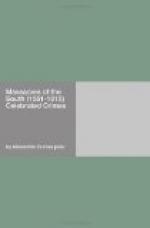M. de Saint-Pons, major of the Nimes legion, hearing some noise outside, opened his window, and found the whole city in a tumult: people were running in every direction, and shouting as they ran that the dragoons were being killed at the palace. The major rushed out into the streets at once, gathered together a dozen to fifteen patriotic citizens without weapons, and hurried to the town hall: There he found two officials of the town, and begged them to go at once to the place de l’Eveche, escorted by the first company, which was on guard at the town hall. They agreed, and set off. On the way several shots were fired at them, but no one was hit. When they arrived at the square, the cebets fired a volley at them with the same negative result. Up the three principal streets which led to the palace numerous red-tufts were hurrying; the first company took possession of the ends of the streets, and being fired at returned the fire, repulsing the assailants and clearing the square, with the loss of one of their men, while several of the retreating cebets were wounded.
While this struggle was going on at the palace, the spirit of murder broke loose in the town.
At the gate of the Madeleine, M. de Jalabert’s house was broken into by the red-tufts; the unfortunate old man came out to meet them and asked what they wanted. “Your life and the lives of all the other dogs of Protestants!” was the reply. Whereupon he was seized and dragged through the streets, fifteen insurgents hacking at him with their swords.
At last he managed to escape from their hands, but died two days later of his wounds.
Another old man named Astruc, who was bowed beneath the weight of seventy-two years and whose white hair covered his shoulders, was met as he was on his way to the gate of Carmes. Being recognised as a Protestant, he received five wounds from some of the famous pitchforks belonging to the company of Froment. He fell, but the assassins picked him up, and throwing him into the moat, amused themselves by flinging stones at him, till one of them, with more humanity than his fellows, put a bullet through his head.




